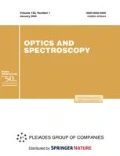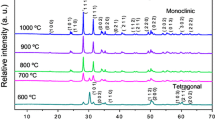Abstract
We investigated the morphology and luminescent properties of ZnO tetrapod powders with copper and gold admixtures, obtained by carbothermal pyrolysis. A broad band in the region of 450–650 nm dominates in the X-ray luminescence spectrum of the samples. There is also a weak edge luminescence band with a maximum at 391 nm. Kinetic measurements showed the presence of both fast (~1 ns) and slow (~850 ns) luminescence components, and the fast component, as a rule, did not exceed 1% of the integrated intensity. The used doping method does not result in the incorporation of copper and gold admixtures into the ZnO lattice. The presence of copper at a concentration of up to 9% does not affect the morphology or luminescence properties of ZnO tetrapods, while gold has such an effect even at a concentration close to 1%.






Similar content being viewed by others
REFERENCES
O. A. Lyapina, A. N. Baranov, G. N. Panin, A. V. Knotko, and O. V. Kononenko, Inorg. Mater. 44, 846 (2008). https://doi.org/10.1134/S0020168508080116
K. Oka, H. Shibata, and S. Kashiwaya, J. Cryst. Growth 237, 509 (2002). https://doi.org/10.1016/S0022-0248(01)01953-4
F. Huang, Z. Lin, W. Lin, J. Zhang, K. Ding, Y. Wang, Q. Zheng, Z. Zhan, F. Yan, D. Chen, P. Lv, and X. Wang, Chin. Sci. Bull. 59, 1235 (2014). https://doi.org/10.1007/s11434-014-0154-4
M. R. Wagner, G. Callsen, J. S. Reparaz, J. H. Schulze, R. Kirste, M. Cobet, I. A. Ostapenko, S. Rodt, C. Nenstiel, M. Kaiser, A. Hoffmann, A. V. Rodina, M. R. Phillips, S. Lautenschläger, S. Eisermann, and B. K. Meyer, Phys. Rev. B 84, 035313 (2011). https://doi.org/10.1103/PhysRevB.84.035313
P. A. Rodnyi, K. A. Chernenko, and I. D. Venevtsev, Opt. Spectrosc. 125, 372 (2018). https://doi.org/10.1134/S0030400X18090205
E. I. Gorokhova, P. A. Rodnyi, I. V. Khodyuk, G. V. Anan’eva, V. A. Demidenko, and E. D. Bourret-Courchesne, J. Opt. Technol. 75, 741 (2008).
E. G. Rakov, Russ. Chem. Rev. 76, 1 (2007). https://doi.org/10.1070/RC2007v076n01ABEH003641
L. N. Demyanets, L. E. Li, A. S. Lavrikov, and S. V. Nikitin, Crystallogr. Rep. 55, 142 (2010). https://doi.org/10.1134/S1063774510010219
Q. Zhu, J. Lu, Y. Wang, F. Qin, Z. Shi, and C. Xu, Sci. Rep. 6, 1 (2016). https://doi.org/10.1038/srep36194
A. M. Opolchentsev, L. A. Zadorozhnaya, Ch. M. Briskina, V. M. Markushev, A. P. Tarasov, A. E. Muslimov, and V. M. Kanevskii, Opt. Spectrosc. 125, 522 (2018). https://doi.org/10.1134/S0030400X1810017X
P. A. Rodnyi, S. B. Mikhrin, A. N. Mishin, and A. V. Sidorenko, IEEE Trans. Nucl. Sci. 48, 2340 (2001). https://doi.org/10.1109/23.983264
N. Y. Garces, L. Wang, L. Bai, N. C. Giles, L. E. Halliburton, and G. Cantwell, Appl. Phys. Lett. 81, 622 (2002). https://doi.org/10.1063/1.1494125
R. Dingle, Phys. Rev. Lett. 23, 579 (1969). https://doi.org/10.1103/PhysRevLett.23.579
Z. A. Khan, A. Rai, S. R. Barman, and S. Ghosh, Appl. Phys. Lett. 102, 022105 (2013). https://doi.org/10.1063/1.4775359
X. B. Wang, C. Song, K. W. Geng, F. Zeng, and F. Pan, Appl. Surf. Sci. 253, 6905 (2007). https://doi.org/10.1016/j.apsusc.2007.02.013
A. N. Gruzintsev, A. N. Redkin, and K. Bartkhou, Semiconductors 44, 628 (2010).
Funding
This work was supported by the Ministry of Science and Higher Education of the Russian Federation within the framework of the State Task of the Federal Research Center “Crystallography and Photonics” of the Russian Academy of Sciences in the part of “obtaining tetrapod powders,” the Russian Foundation for Basic Research (in the part of “structural diagnostics of tetrapod powders” project no. 18-29-12099 MK) and in the part of “investigation of the luminescence and scintillation characteristics of tetrapods” (project no. 18-52-76002 ERA_a).
Author information
Authors and Affiliations
Corresponding author
Ethics declarations
The authors declare that they have no conflict of interest.
Additional information
Translated by O. Zhukova
Rights and permissions
About this article
Cite this article
Venevtsev, I.D., Muslimov, A.E., Zadorozhnaya, L.A. et al. X-Ray Luminescence of ZnO Tetrapods Grown in the Presence of Copper and Gold Admixtures in Initial Charge. Opt. Spectrosc. 128, 1784–1788 (2020). https://doi.org/10.1134/S0030400X20110272
Received:
Revised:
Accepted:
Published:
Issue Date:
DOI: https://doi.org/10.1134/S0030400X20110272




